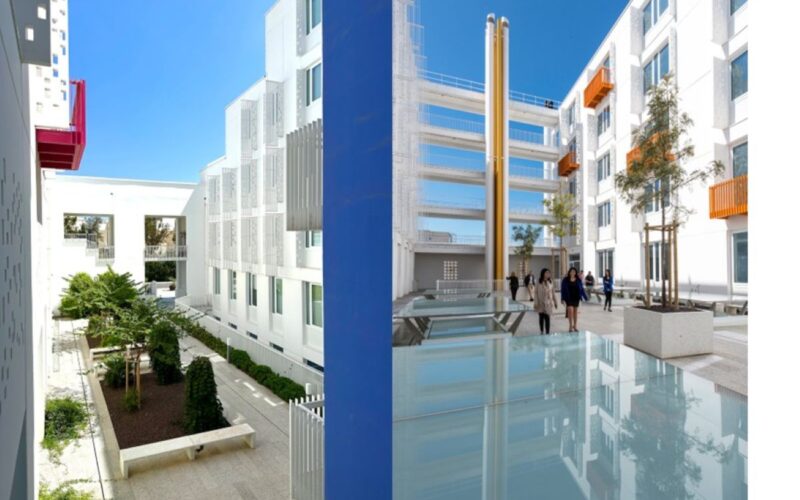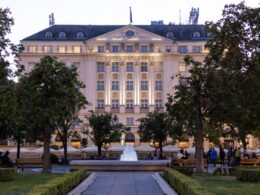Professor Ian Ritchie addressed Ħaġra – Malta’s Festival of Contemporary Mediterranean Architecture. Times2 finds out more.
For Ħaġra, I explored the conceptual and technical approach to historic settings and illustrated this with some of the major contemporary interventions my practice made into historic settings such as the Louvre, (1983-93), Centro Arte Reina Sofia in Madrid (1990) and many others. I also discussed how we have created global architectural fashions in glass and stone gabion innovative structures. These included the world firsts in structural glazing at the Science City La Villette, Paris, and the stone gabion cantilever structure in architecture in the Gardens of the Imagination at Terrasson La Villedieu in France, and structural cast glass at the SWC for Neural Circuits and Behaviour at UCL, London (2014).
I then explained how Art Deco emerged as powerful decorative design language for factories, and hence to the design of Farsons Brewery at Mrieħel in Malta. Art Deco began in France in the 1920s, expanded throughout the world as a fashionable style of decorative architecture in 1930s – including famous factories in London for US companies such as Firestone, Hoover and Carrera Cigarettes through to the late 1940s when Lewis V Farrugia with William Binnie (also designed the Phoenicia Hotel Floriana) used the Art Deco style when designing the new Farsons Brewery complex at Mriehel which opened in 1950. In 2013 it became the first industrial building in Malta to be Grade II listed.
As an architect, I have been an advocate of energy conscious design since the first oil crisis in 1974. Relating our work t the climate crisis, I discussed how we designed and built solar powered private houses in France (Fluy House 1976) and England (Eagle Rock House 1980 – using solar energy and an air-air heat pump).

Farsons launched an international architectural competition in October 2013 which was won by ritchie*studio in March 2014. The practice was chosen for our understanding of its heritage value, poetic creativity coupled with a rigorous engineering approach.
When the Trident Park board then embarked on realising the mixed development in Mrieħel [a large-scale regeneration project], they made a commitment to invest in heritage and in the future of Maltese enterprise based upon the principles of business ethics, social values, and respect for cultural history. They also fully embraced the need for a sustainable green energy approach combined with adaptable space to ensure the project’s viability and longevity.
The Art Deco Brewery was transformed into a large-scale creative mixed-use sustainable workplace totalling 22,000 square metres – a major regeneration scheme embracing heritage, landscape, and contemporary architecture – which retained all of the old brewhouse (7,000m). The building was reimagined and transformed into multi-use accommodation for young companies, museum, food and beverage outlets and education, with new landscaped courtyards and square metres of low-energy offices (15,000) and conference centre behind the 200m colonnade. The project was completed in February 2023.
The Maltese people have always had to be careful stewards of their natural resources, using them with prudence and respect. This mindfulness has become part of the Maltese culture. Malta is legally committed to reaching climate neutrality by 2050 and is working to transition to renewable energy, reduce emissions, and adapt its infrastructure. Malta has increased its Renewable Energy Supply (RES) in the last ten years from 1.5% to 10% today, primarily from private and small-scale commercial land-based photovoltaics.
At the inauguration of Trident Park and the Old Brewhouse in June 2023 by Malta’s Prime Minister and Archbishop, I mentioned Robert Abuela’s 2022 UN speech, in which he emphasised the need for global peace, security and prosperity to ensure an equitable and socially harmonious quality of life.

The richest 1% of humanity has vastly more impact on the world’s climate than the poorest 50%. This is offensive. The 1% must change their focus from short-term profit to the long-term legacy they leave behind. A new narrative and activism must encourage them to feel engaged as responsible guardians of an all-electric future based on renewable energy.
In essence, it is about changing the thinking of big investors — banks, pension funds. Their portfolio investments must rapidly shift from fossil fuels toward renewables. The need is self-evident; the renewable energy industry already employs almost 14 million people. Regrettably, many major oil companies have reduced green energy investment targets.
We must dismiss the argument that we cannot just become all-electric overnight; we all know this, and it neuters urgency to invest in green energy. Green energy presents challenges, because power can only be generated intermittently, and currently we can only store enough power for a few hours, despite longer-term localised storage facilities. More investment and research are needed.
Balancing the competing priorities of energy security and renewable energy is by far our biggest climate challenge. Although changing individual consumer behaviour is critical, the biggest and fastest game-changer for climate is diverting our energy source away from fossil fuels.
Many people on social media have come to trust unqualified opinion-makers on climate change rather than experts grounded in qualified, evidence-based science. Nevertheless, recent polls put global opinion at 80% that climate change is happening and is man-made.
I am an ambassador for Global Returns Project and have been a member of Scientists for Global Responsibility for more than 30 years.
For more than 50 years I have actively designed, published and spoken internationally about the need for ideas and imagination to reduce energy consumption and to mitigate climate change.
These activities, along with my design philosophy of energy-conscious design, are personal commitments and they have had impact. Trident Park is one example.
My practice has actively sought to optimise structures and building envelopes by using less material and reducing the carbon profile of building materials, particularly cement. Gordon Talbot, a director in the practice, has advocated substituting as much as 70% of Ordinary Portland Cement with low carbon alternatives such as Ground Granulated Blast Furnace Slag (GGBS).
Local stone is always the best ecological and environmental material for low carbon construction if it is available, affordable, the necessary skills are available to make quarrying economically viable, and that can be done without air pollution. Coralline Limestone and a soft Globigerina Limestone known as tal-Franka are Malta’s native stones, and constructing with them is sensible, as is recycling stone when it becomes available.
Architectural quality was a key ambition for Trident Park Ltd., achieved with a strong environmental and sustainable design agenda as a priority. The design creates a unique architectural language while reducing the building’s impact on climate change. Façades face shared landscaped courtyards and vertical circulation cores. Air quality, natural light, and a sense of place create an enjoyable environment for workers and visitors.
Landscape was the primary design driver, delivering public amenity and clean air. Rejecting conventional air-conditioning, we incorporated a Thermally Activated Building Structure (TABS) using closed-loop water at 16/17 deg. C. complemented by building shading, fixed vertical brises soleil, and opening windows. The development’s lifetime carbon footprint is 56% lower than typical current construction in Malta.
Developers and their investors can have an overwhelming impact on an island like Malta. Skyscrapers represent globalisation, not regional or cultural identity, isolation rather than community. They destroy traditional urbanism and urban values that were built on designing for people and with nature. It is a capital- and energy-intensive built form with exceptional operational and maintenance requirements. Its only objective is to maximise financial return by maximising rentable space on a small plot of land. The impact 9/11 had on skyscraper’s capital and operational costs was compounded a decade later by the pandemic. The skyscraper should be consigned to history.
Inspired by Maltese palace gardens and the coloured architectural elements of the island’s vernacular buildings, and designed with respect for the force of the Mediterranean sun, Trident Park’s utterly contemporary mixed-use commercial architecture has been described as a masterpiece of form, light and shade, sustainability and environmental engineering. Richard England, the celebrated Maltese architect wrote:
“It is perhaps the finest building our island has seen over many a decade. It proves that real estate development can be produced enriched with what Vitruvius termed ‘Venustas’.
Rarely has Malta seen architecture of this excellence.”
The next phase of Trident Park will continue to invest in these qualities.
We believe that the Trident Park project, realised through shared values with our client, has given the Maltese Planning Authority and Climate Action Authority a benchmark for commercial development and architectural quality that can inspire others to help preserve this island’s beauty for future generations.
After all, the art of architecture is to support our shared aspirations and common goals: peaceful coexistence within a shared, beautiful environment that inspires calm, happiness and harmony that resonates with our historic built environment.

The story behind Trident Park is captured in the book Renewal Architects printed at Gutenberg Press Malta and published by Unicorn in 2023.
This article was supplied by Professor Ian Ritchie, Founder and Director of Ritchie*Studio (1981)










